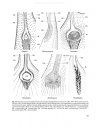About this book
Language: English
Dileptids are holotrichously ciliated, rapacious ciliates with a conspicuous proboscis carrying a complex ciliary pattern. Most species have a wide or global distribution, occurring in limnetic, marine, and terrestrial environments as well as in benthic and planktonic habitats. Light- and electronmicroscopical investigations suggested the dileptids as strongly derived crown Litostomatea (Gymnostomatea pro parte, Haptoria p.p., Trichostomatia p.p.) because of their complex morphology and ontogenesis. However, recent molecular studies show the opposite: the dileptids form a distinct clade at the base of the litostomateans, supporting the subclass Rhynchostomatia established by Jankowski (1980). The last common ancestor of dileptids and other litostomateans (Haptoria, Trichostomatia) was possibly a rather complex ciliate with a paroral membrane (~ circumoral kinety) and many adoral membranelles (~ preoral kineties).
The genus Dileptus was established by Dujardin (1841). Although afterwards some interesting studies on dileptid biology and diversity were performed, progress was slow during the next ninety years. In 1931, Kahl revised the dileptids recognizing three genera (Dileptus, Paradileptus, Trachelius) and 25 nominal species, including eight new ones. After Kahl's classic study, more protozoologists became interested in the biology and taxonomy of the dileptids, which culminated in the monograph of Dragesco (1963). He revised the genus Dileptus and recognized about 50 species, showing that dileptid diversity doubled between 1931 and 1963. In the following decades, the number of genera and species increased slowly but steadily. In this monograph, the authors recognize 12 genera and 181 nominal species, of which 66 are possibly reliable dileptid taxa; however, only 46 species and subspecies are so well described that their identity is not threatened. They establish two new genera (Apotrachelius and Microdileptus) and 18 new species and subspecies including those recently described by Vïaèný & Foissner (2008a, b): Apodileptus edaphicus, A. visscheri rhabdoplites, Apotrachelius multinucleatus, Dileptus sphagnicola, Dimacrocaryon amphileptoides paucivacuolatum, D. arenicola, D. brasiliense, Microdileptus microstoma, M. semiarmatus, Pseudomonilicaryon brachyproboscis, P. fraterculum, P. gracile antevacuolatum, P. gracile oviplites, P. marinum minimum, Rimaleptus brasiliensis, R. canadensis, R. longitrichus, and R. tirjakovae. Further, the authors redescribe and/or provide additional figures for ten species: Apodileptus visscheri visscheri, Dileptus anatinus, D. costaricanus, Monomacrocaryon polyvacuolatum, M. terrenum, Pelagodileptus trachelioides, Pseudomonilicaryon falciforme, P. thononense, Rimaleptus armatus, and R. binucleatus. The synonymy rate is 27.5% but increases to 60.5% when taxa with "unclear identity" are included.
Monograph of the Dileptids (Protista, Ciliophora, Rhynchostomatia) commences with a detailed general section, showing the dileptid morphology, ultrastructure, resting cysts, ontogenesis, conjugation, ecology, and phylogeny. Further, the authors provide protocols for the methods used in studying the dileptid organization (live observation, silver nitrate impregnation, protargol impregnation, scanning electron microscopy) and a detailed terminology. In the main section of the monograph, they provide, if available, the following data for each species: author, date, and journal page of the original description; a list of synonyms; nomenclatural matters; a morphological treatise including the original description, redescriptions, and all figures published; morphometric data; details on ontogenesis and resting cysts; a comparison with related species; and a detailed compilation of ecological and faunistic data. Monograph of the Dileptids (Protista, Ciliophora, Rhynchostomatia) ends with a carefully prepared reference section and an index to the scientific names mentioned in the text.
Contents
Introduction 3
A. General Section 4
1 Morphology and Principal Terms 4
2 Life cycle: Ontogenesis, Conjugation and Resting Cysts 31
3 Ecology, Occurrence and Geographic Distribution 58
4 Phylogeny and Evolution 61
5 Classification 75
6 Synonymy rate 75
7 List of Genera and Nominal Species Associated with Dileptids 82
8 Summary of New Taxa and Nomenclatural Acts 82
9 Collecting, Culturing, Observing, and Staining of Dileptid Ciliates 86
B. Systematic Section 98
1 How to Use the Monograph 98
2 A User-Friendly Flow Chart Key to 66 Dileptid Species 98
Subclass Rhynchostomatia 109
Order Tracheliida 110
Family Tracheliidae 110
Genus Trachelius (1 species) 111
Genus Apotrachelius (1 species) 135
Order Dileptida 142
Family Dimacrocaryonidae 143
Genus Monomacrocaryon (4 species) 143
Genus Dimacrocaryon (4 species and subspecies) 161
Genus Rimaleptus (18 species) 179
Genus Microdileptus (3 species) 242
Family Dileptidae 262
Genus Dileptus (10 species) 265
Genus Apodileptus (3 species and subspecies) 323
Genus Monilicaryon (1 species) 343
Genus Pseudomonilicaryon (19 species and subspecies) 350
Genus Paradileptus (1 species) 437
Genus Pelagodileptus (1 species) 451
Insufficiently described and doubtful dileptids 465
From Various Authors 466
From Dumas (1929–1937) 472
Acknowledgements 478
References 478
Systematic Index 516
Customer Reviews




















![Kommentierter Katalog der Neuropterida (Insecta: Raphidioptera, Megaloptera, Neuroptera) der Westpaläarktis [Annotated Catalogue of the Neuropterida of the Western Palearctic]](http://mediacdn.nhbs.com/jackets/jackets_resizer_medium/12/125872.jpg?height=150&width=116)
![Mollusca (Weichtiere): Beiträge zur Kulturgeschichte, Forschung und Sammlungen aus Österreich [Molluscs: Contributions to Cultural history, Research and Collections from Austria]](http://mediacdn.nhbs.com/jackets/jackets_resizer_medium/24/248512.jpg?height=150&width=111)
![Lebensräume von Köcherfliegen (Trichoptera) [Habitats of Caddisflies (Trichoptera)]](http://mediacdn.nhbs.com/jackets/jackets_resizer_medium/23/231579.jpg?height=150&width=111)
![Die Heuschrecken Österreichs [The Grasshoppers of Austria]](http://mediacdn.nhbs.com/jackets/jackets_resizer_medium/23/237433.jpg?height=150&width=117)
![Der Rudolfstollen in Linz-Urfahr (Österreich) und Seine Umgebung: Eine Naturwissenschaftlich-Historische Bestandsaufnahme [The Rudolfstollen in Linz-Urfahr (Austria) and Its Surroundings: A Natural History and Historical Inventory]](http://mediacdn.nhbs.com/jackets/jackets_resizer_medium/23/237499.jpg?height=150&width=114)
![Höhlen und Karst in Österreich [Caves and Karst in Austria]](http://mediacdn.nhbs.com/jackets/jackets_resizer_medium/23/237975.jpg?height=150&width=115)









![Guide des Tuniciers de l'Europe de l'Ouest: Atlantique & Méditerranée [Guide to Western European Tunicates: Atlantic and Mediterranean]](http://mediacdn.nhbs.com/jackets/jackets_resizer_medium/26/263079.jpg?height=150&width=104)



![Wolfsblut und Lohblüte: Lebensformen Zwischen Tier und Pflanze [Myxomycetes: Lifeforms Between Animals and Plants]](http://mediacdn.nhbs.com/jackets/jackets_resizer_medium/18/185495.jpg?height=150&width=115)

![Reise durch die Natur Jordaniens [Journeys through Jordan's Nature] [English / German]](http://mediacdn.nhbs.com/jackets/jackets_resizer_medium/15/157755.jpg?height=150&width=113)



![Atlas der Brutvögel Oberösterreichs 2013-2018 [Atlas of Breeding Birds in Upper Austria 2013-2018]](http://mediacdn.nhbs.com/jackets/jackets_resizer_medium/25/253618.jpg?height=150&width=114)